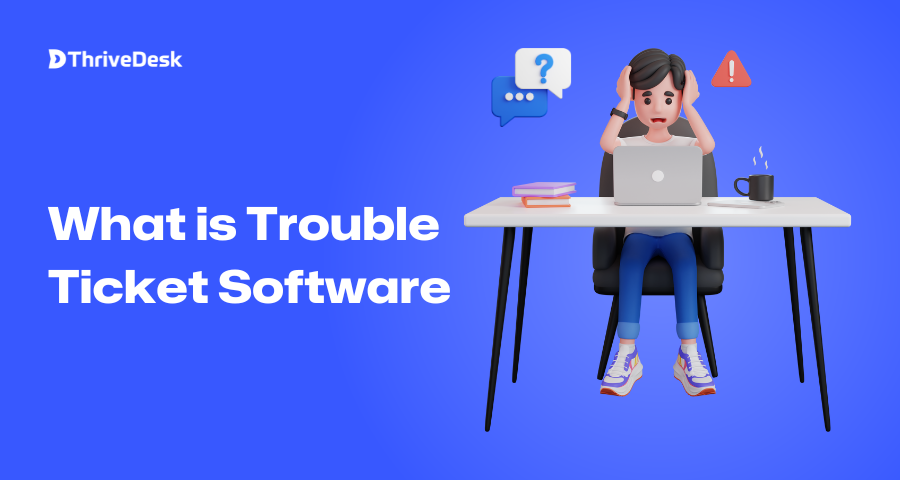Are you drowning in a sea of customer inquiries?
Are you struggling to keep track of customer issues bouncing around your inbox or lost in phone calls?
Dreading that eventual bad customer review on account of an unresolved customer issue?
Fear not! There’s a powerful tool designed to streamline your support process and bring order to the chaos: trouble ticket software.
This comprehensive guide will be your lifeline, explaining everything you need to know about trouble ticket systems. We’ll delve into what it is, how it works, and the numerous benefits it offers for businesses of all sizes, which are the best on the market right now.
So, make yourself a coffee, get comfortable on the couch, and just read on.
What is Trouble Ticket Software?
Trouble ticket software is a digital platform designed to streamline the process of managing and resolving customer issues. It acts as a central hub for tracking and organizing all your support requests, replacing the inefficiency of emails, phone logs, and scattered notes.
Here’s a breakdown of the key concepts:
Trouble Ticket: A digital record representing a specific customer issue or request. It contains details like the problem description, urgency level, customer information, and any associated notes or attachments.
Trouble Ticket Software: A software application used to create, manage, and track these trouble tickets throughout their lifecycle, from initial reporting to final resolution.
What does it do?
Trouble Ticket Software has various functionalities and features that serve multiple use cases. Below you’ll find a general breakdown of what it is mostly used as.
1. Intake and Ticketing
Submission Channels: Customers can submit issues through various channels like a web portal, email, phone calls, or even social media integrations.
Ticket Creation: The system captures all relevant information like the problem description, contact details, urgency level, and any attachments. It then automatically generates a unique ticket ID for easy tracking.
Automatic Routing: Based on pre-defined rules (e.g., issue category, product line), the ticket gets routed to the most qualified support agent for faster resolution.
2. Communication and Collaboration
Internal Communication: Agents can discuss the ticket internally, mention teammates, share notes, and collaborate to diagnose and fix complex issues.
Customer Communication: The system facilitates clear communication with the customer. Agents can send updates, request additional information, or provide solutions directly within the ticket. Customers can track progress, ask clarifying questions, and provide feedback.
3. Workflow Management and Automation
Ticket Status Tracking: Tickets move through predefined stages (e.g., Open, In Progress, Pending Information, Resolved, Closed) offering a clear view of progress and helping prioritize tasks.
Automated Workflows: Repetitive tasks like sending initial acknowledgement emails, escalating overdue tickets, or notifying the customer of resolution can be automated for efficiency.
SLA Management: Service Level Agreements (SLAs) can be defined for different issue types, ensuring timely response and resolution within agreed-upon timeframes. The system can track SLA adherence and generate alerts for potential breaches.
4. Knowledge Base Integration
Knowledge Base Articles: The system may integrate with a knowledge base containing solutions to frequently encountered problems.
Self-Service Options: Customers can search the knowledge base for solutions before submitting a ticket, potentially resolving issues independently, reducing agent workload.
Suggested Solutions: Based on keywords in the ticket description, the system can suggest relevant knowledge base articles to agents, aiding faster resolution.
5. Reporting and Analytics
Performance Dashboards: The system provides insights into key performance indicators (KPIs) like average resolution time, first contact resolution rate, agent performance metrics, and customer satisfaction levels.
Reporting Tools: Generate reports on various aspects of support operations, allowing you to identify areas for improvement and make data-driven decisions.
Different Types of Help Desk Trouble Ticket Systems
Trouble ticket software comes in various deployment models to suit your needs:
- Web-based: Cloud-hosted solution accessible from any device with an internet connection. Easy to set up and maintain, with subscription-based pricing.
- On-premises: Software installed on your own servers, offering greater control and customization, but requiring upfront investment and IT maintenance.
- Cloud-based: Similar to web-based, but offers potentially greater scalability and redundancy as the software resides on the vendor’s infrastructure.
The best type for you depends on factors like budget, IT resources, security needs, and desired level of customization.
10 Best Trouble Ticket Software: At a Glance
Below are 10 of the best Trouble Ticket Software currently on the market in 2024. We’ve picked them based on use cases, key features that businesses want and competitive pricing.
| Software | Pricing | Key features | Use cases |
|---|---|---|---|
| ThriveDesk | Starts at $25/month (4 agents included) | Affordable, unified inbox for email & live chat, conversational AI, AI powered editor, powerful automations, Customer service portal (WP Portal), GDPR compliance, varied integrations | Ideal for startups and small businesses seeking a simple yet feature-rich solution |
| Zendesk | Starts at $69/agent per month | Robust ticketing system, omnichannel support, self-service portal, reporting & analytics | All-around solution for businesses of all sizes |
| Jira Service Management | Starts at $22.05/agent per month | Integrates with Jira project management, customizable workflows, automation capabilities | Ideal for IT help desks and development teams |
| Zoho Desk | Starts at $20/user per month | Multi-channel support, built-in social media integrations, mobile apps for agents & managers, SLA management | Good for customer service teams in various industries |
| Freshdesk | Starts at $15/agent per month | User-friendly interface, gamification features for agent motivation, AI-powered automation | Suitable for small and medium businesses with moderate support needs |
| LiveAgent | Starts at $9/agent per month | Live chat & chatbot integration, omnichannel ticketing, built-in help desk gamification | Omnichannel customer support for e-commerce and marketing teams |
| ServiceNow | Custom pricing | Enterprise-grade platform, IT service management (ITSM) capabilities, extensive customization options | Large organizations with complex IT infrastructure needs |
| Help Scout | Starts at $25/user per month | Shared inbox for collaborative support, built-in knowledge base, customer satisfaction surveys | Small businesses with a focus on personalized customer service |
| HappyFox | Starts at $39/agent per month | Automated ticket routing, multilingual support, real-time reporting dashboards | Customer support for agencies managing multiple brands or clients |
| osTicket | Starts at $9/user per month | Free and customizable, limited features compared to paid options, requires IT expertise for setup and maintenance | Cost-effective option for small businesses with basic support needs |
10 Best Trouble Ticket Software: In Depth
ThriveDesk
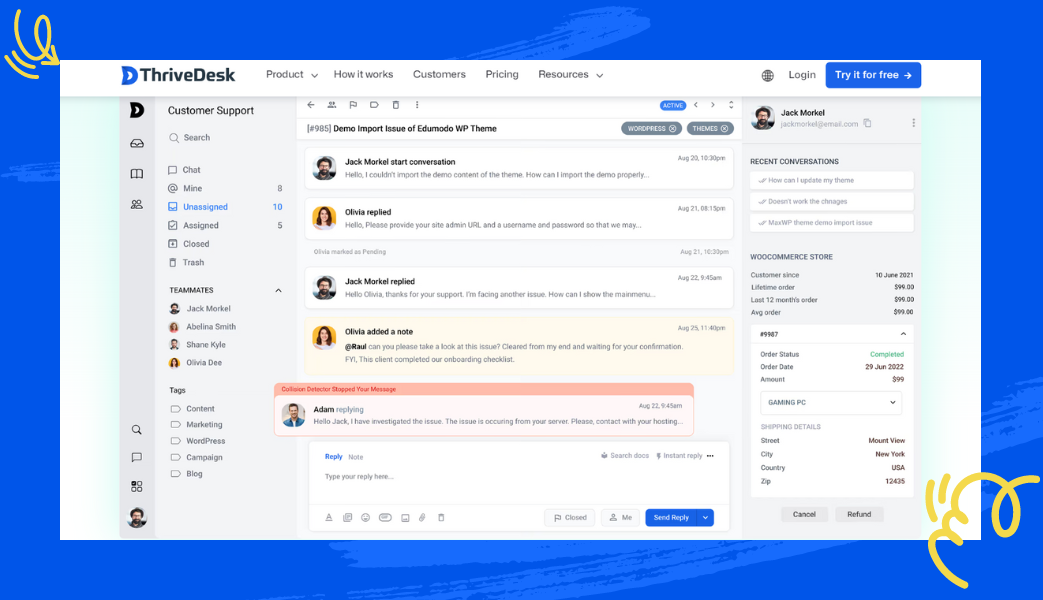
ThriveDesk is a cloud-based trouble ticket software designed to simplify customer support for startups and small businesses. It offers a unified inbox for managing email and live chat inquiries, alongside powerful automation features, conversational AI tools, and strong GDPR compliance.
Key features
- Unified Inbox: Manage all customer interactions (emails, live chat) from a single platform, streamlining communication and reducing agent workload.
- Conversational AI: Utilize chatbots to answer basic questions, deflect tickets, and qualify leads, freeing agents to focus on complex issues.
- Automation Capabilities: Automate repetitive tasks like ticket routing, sending notifications, and generating canned responses for increased efficiency.
- Live Chat Support: Offer real-time assistance to website visitors and convert website traffic into leads or sales directly within ThriveDesk.
- Knowledge Base Integration: Build a self-service knowledge base with FAQs and troubleshooting guides to empower customers to resolve issues independently.
- Collaboration Tools: Facilitate internal communication between agents through notes, mentions, and task assignments within tickets.
- Reporting and Analytics: Gain insights into support performance with reports on resolution times, agent productivity, and customer satisfaction metrics.
- Mobile Apps: Access ThriveDesk on the go with mobile apps for agents and managers, ensuring uninterrupted support operations.
- GDPR Compliance: Built with features to comply with GDPR regulations, ensuring data privacy and security for customers in the EU.
Pros:
- ThriveDesk offers a freemium plan with basic features, and its paid plans are competitively priced compared to other solutions.
- The user interface is intuitive and easy to learn, making it ideal for teams with minimal technical expertise.
- Built-in automation features streamline workflows and free up agents to focus on more strategic tasks.
- Chatbots powered by AI can deflect simple inquiries and improve customer experience.
- No software installation required, accessible from any device with an internet connection.
Cons:
- While offering core functionalities, ThriveDesk may lack the extensive customization options found in enterprise-grade solutions.
- ThriveDesk offers a good range of integrations, but the selection might be smaller compared to some competitors.
ThriveDesk Pricing
ThriveDesk offers extremely reasonable pricing for small to mid tier businesses. Paid plans start at around $25/month, with four agents included, additional features, and increased agent capacity available in higher tiers.
Zendesk
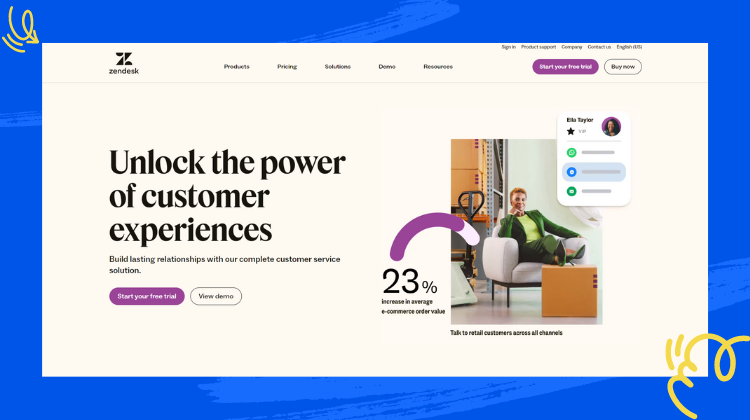
Zendesk is a cloud-based ticketing system designed to streamline customer service interactions and improve agent productivity. It acts as a central hub for all your customer inquiries, consolidating requests from various channels (email, chat, social media) into a single, organized system.
Key Features
- Omnichannel Ticketing: Manage all customer interactions from a unified platform, regardless of the channel used (email, chat, phone, social media).
- Automated Workflows: Streamline repetitive tasks with automated routing, prioritization, and predefined responses (canned responses).
- Self-Service Portal: Empower customers to find solutions independently through a knowledge base and community forum.
- Reporting & Analytics: Gain valuable insights into customer behavior and agent performance with comprehensive reports and dashboards.
- Scalability & Customization: Zendesk adapts to your business size and needs with flexible plans and a wide range of integrations.
Pros:
- Reduces ticket resolution time and increases agent productivity with automation and a centralized workspace.
- Provides a seamless omnichannel experience and empowers customers with self-service options.
- Accommodates businesses of all sizes, from startups to large enterprises.
- Integrates with various third-party applications and offers customization options to tailor the platform to your specific needs.
Cons:
- While user-friendly, Zendesk may require some initial training for new agents to leverage all its features.
- Can be expensive for smaller businesses with basic needs. Higher tiers offer advanced features but come with a steeper price tag.
Zendesk Pricing
Zendesk offers structured plans with good spread of features. The paid plans start at $69/user per month. The plans differ in varying functionalities and pricing structures. The cost depends on the number of agents and features required. It’s recommended to visit the Zendesk website for a detailed pricing breakdown.
Jira Service Management
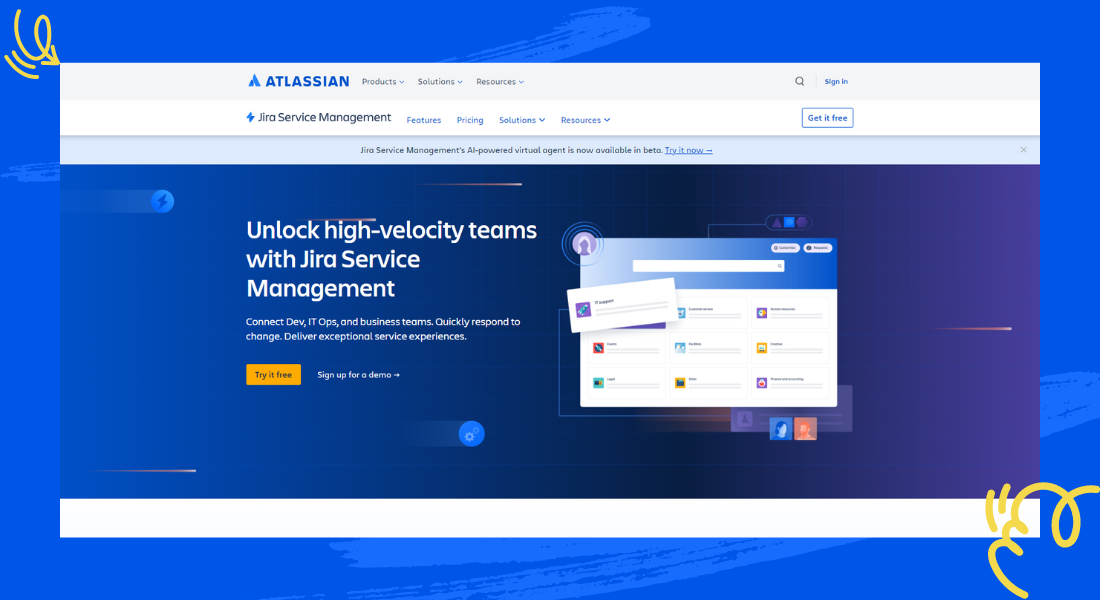
Jira Service Management is a trouble ticket software built on the foundation of Jira, a popular project management platform. It allows organizations to streamline their support processes by offering a central hub for tracking, managing, and resolving customer and internal requests.
Key Features
- Ticketing System: Capture, categorize, and prioritize trouble tickets efficiently.
- SLA Management: Set and track Service Level Agreements (SLAs) to ensure timely resolution of issues.
- Automation: Automate repetitive tasks and workflows for faster resolution times.
- Self-Service Portal: Empower users to find solutions through a knowledge base and community forums.
- Team Collaboration: Facilitate communication and collaboration between support agents and development teams.
- Reporting & Analytics: Gain insights into team performance and identify areas for improvement.
- Integrations: Integrates with various tools like Slack, Confluence, and other Atlassian products for a unified workflow.
Pros:
- Adapts to the needs of growing teams and ticket volume.
- A customizable platform that can be tailored to specific workflows.
- Provides a clear overview of all support requests and their progress.
- Fosters communication and teamwork across departments.
- Reduces manual work and improves efficiency.
Cons:
- Initial setup and user familiarization can require some training.
- Pricing can be expensive for smaller teams compared to basic help desk solutions.
- The feature-rich nature might be overwhelming for simple support needs.
Jira Service Management Pricing
Jira Service Management offers a tiered pricing structure based on the number of agents and features required. There’s a free plan for up to 3 agents, with paid plans starting at $22.05/user per month.
Zoho Desk
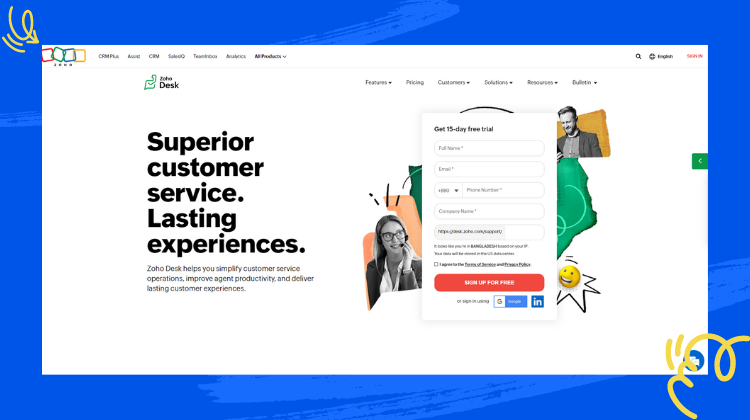
Zoho Desk is a cloud-based trouble ticket software designed to streamline customer support operations. It offers a centralized platform for managing customer inquiries across various channels, including email, web forms, and self-service portals.
Key Features
- Multichannel Ticketing: Manage support tickets from various sources in a unified interface.
- Automation: Automate repetitive tasks like ticket routing, prioritization, and escalation.
- AI-powered Assistant (Zia): Leverage Zia for sentiment analysis, suggesting relevant knowledge base articles, and even chatting with customers.
- Team Collaboration: Facilitate teamwork through internal notes, tagging colleagues, and team assignments within tickets.
- Reporting & Analytics: Gain insights into customer support performance with detailed reports and customizable dashboards.
- Mobile App: Manage tickets and stay updated on the go with the Zoho Desk mobile app.
Pros:
- Easy to use and intuitive interface.
- Affordable pricing plans, including a free tier.
- Scalable solution suitable for businesses of all sizes.
- AI-powered features enhance efficiency and customer satisfaction.
- Strong team collaboration capabilities.
Cons:
- Limited customization options compared to some competitors.
- Advanced reporting features might require additional investment.
- Free plan has limitations on agents and functionalities.
Zoho Desk Pricing
Zoho Desk offers a variety of straightforward pricing plans stating at $20/agent per month. The pricing increases based on the number of agents, features included, number of email channels and the length of the subscription etc.
Freshdesk
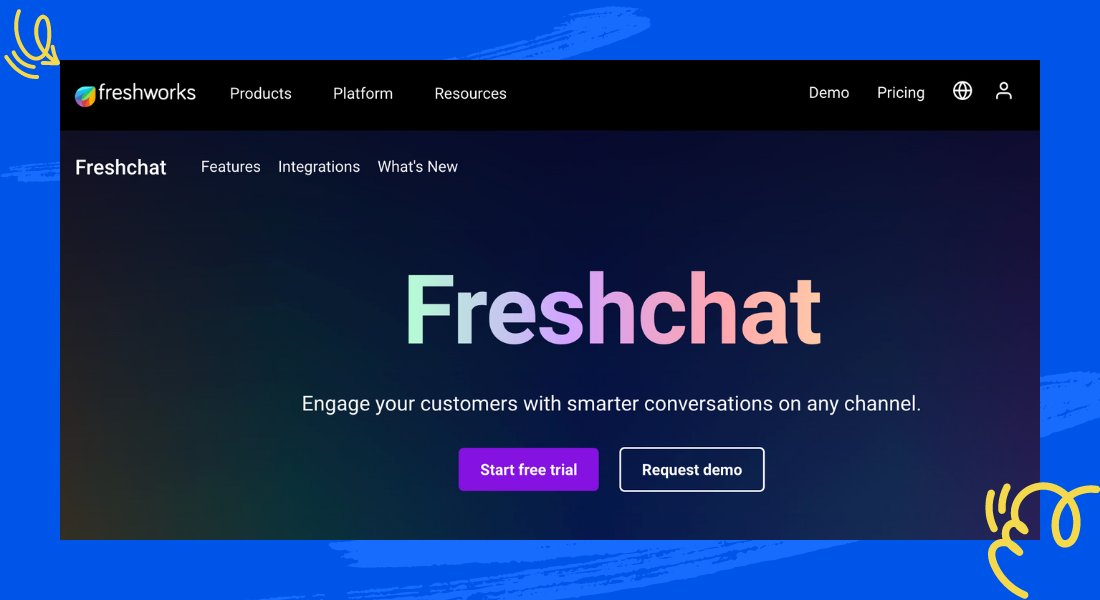
Freshdesk is a cloud-based trouble ticket software designed to streamline and automate your customer support process. It offers a unified workspace for agents to manage, prioritize, and resolve tickets efficiently.
Key Features
- Ticketing System: Manage and track all customer inquiries through a centralized platform.
- Self-Service Portal: Empower customers to find solutions independently with a knowledge base and FAQ section.
- Automation: Automate repetitive tasks and workflows using AI-powered features.
- Collaboration Tools: Facilitate teamwork among agents with internal notes and collision detection.
- Reporting & Analytics: Gain valuable insights into customer behavior and agent performance with reports and dashboards.
- Integrations: Connect Freshdesk with various third-party applications for a unified customer experience.
Pros
- User-friendly interface for both agents and customers.
- Scalable solution that adapts to growing businesses.
- AI-powered automations improve efficiency and reduce workload.
- Self-service options deflect common support requests.
- Comprehensive reporting and analytics provide actionable insights.
Cons
- Limited customization options compared to some competitors.
- Free plan has restricted features and limited support.
- Higher pricing tiers may be expensive for small businesses.
Freshdesk Pricing
Freshdesk offers a freemium model with paid plans starting at $15/agent per month. Pricing varies based on features and the number of agents required and size of your business. They cater to all sizes starting from small to enterprise level businesses.
LiveAgent
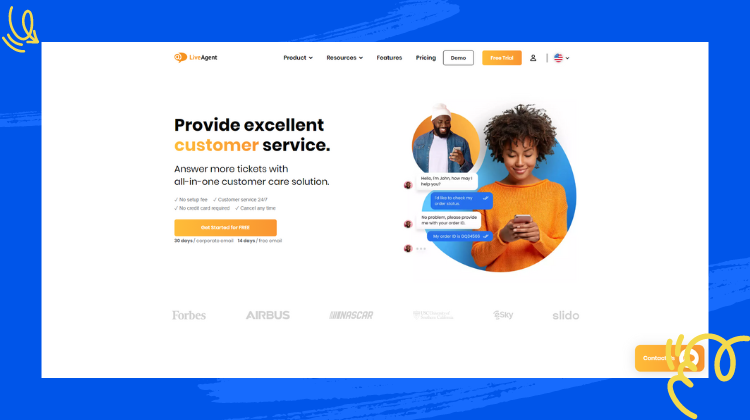
LiveAgent is a cloud-based trouble ticket software designed to streamline customer support interactions. It offers a unified platform to manage inquiries from various channels like email, live chat, social media, and phone calls, all within a user-friendly interface.
Key features
- Multi-channel Ticketing System: Manage all customer communication through a single platform.
- Automation Features: Automate repetitive tasks like ticket routing and auto-responders.
- Self-Service Portal: Empower customers to find solutions through a knowledge base and community forums.
- Reporting & Analytics: Track agent performance and identify areas for improvement.
- Integrations: Connect LiveAgent with your existing CRM, marketing, and other business tools.
Pros:
- Intuitive interface with a short learning curve for agents.
- Suitable for businesses of all sizes, from small teams to large enterprises.
- Competitive pricing plans with a free option available.
- Manage inquiries from various communication channels.
- Saves time and improves agent efficiency.
Cons:
- The free plan offers basic functionalities and restricts the number of agents.
- Customization options: While customizable, extensive customization might require additional support.
LiveAgent Pricing
LiveAgent offers a variety of pricing packages starting with $9/agent per month. The pricing varies based on the number of agents, features included, and billing cycle. You can find a detailed breakdown of their pricing structure on their website.
ServiceNow
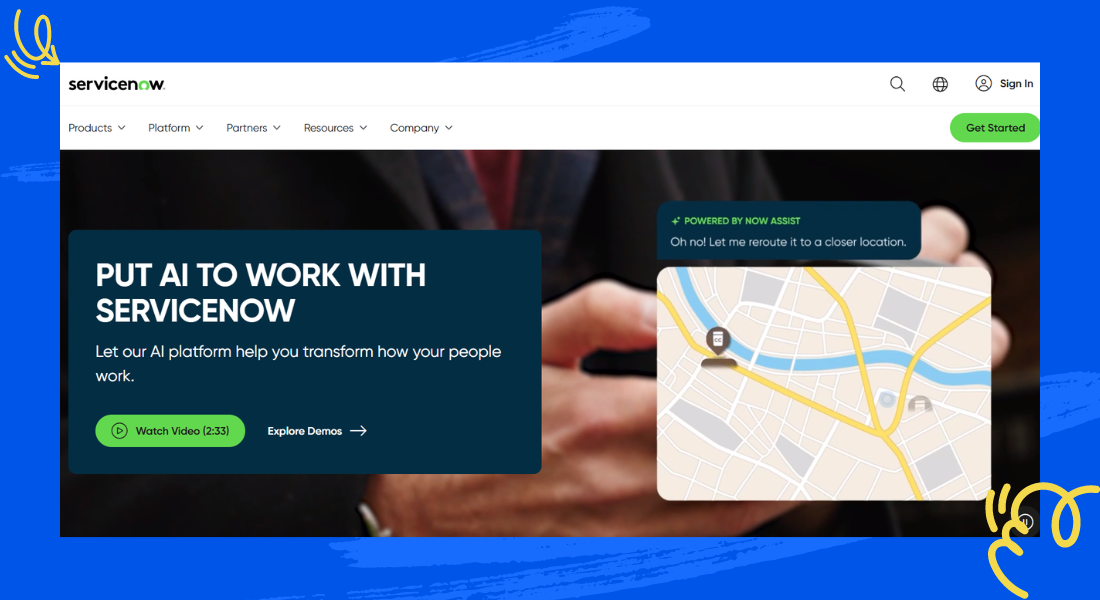
ServiceNow is a cloud-based platform that offers a comprehensive IT service management (ITSM) solution, including a robust trouble ticket system. It allows organizations to manage various types of service requests, incidents, and problems in a centralized location.
Key Features
- Ticketing System: Submit, track, and resolve trouble tickets with automated workflows and prioritization.
- Incident Management: Streamline incident identification, categorization, and resolution.
- Self-Service Portal: Empower employees to find solutions and submit tickets independently.
- Knowledge Base Management: Create and store knowledge base articles for faster troubleshooting.
- Automation: Automate routine tasks for improved efficiency.
- Reporting and Analytics: Gain insights into IT service performance and identify areas for improvement.
- Customization: Tailor ServiceNow to fit your organization’s specific needs with custom workflows and integrations.
Pros
- Manage all IT service requests in one place.
- Automate workflows and streamline troubleshooting.
- Facilitate communication between IT staff and end-users.
- Accommodate growing organizations and service demands.
- Adapt the platform to your unique needs.
Cons
- Setting up and customizing ServiceNow can be expensive.
- The platform offers a wide range of features, which may require training for full utilization.
- Ongoing subscription fees are required.
ServiceNow Pricing
ServiceNow employs a tiered pricing model with varying costs based on features and functionalities. For specific pricing details, it’s recommended that you contact ServiceNow directly for a customized quote. They do not offer off-the-shelf pricing packages.
Help Scout
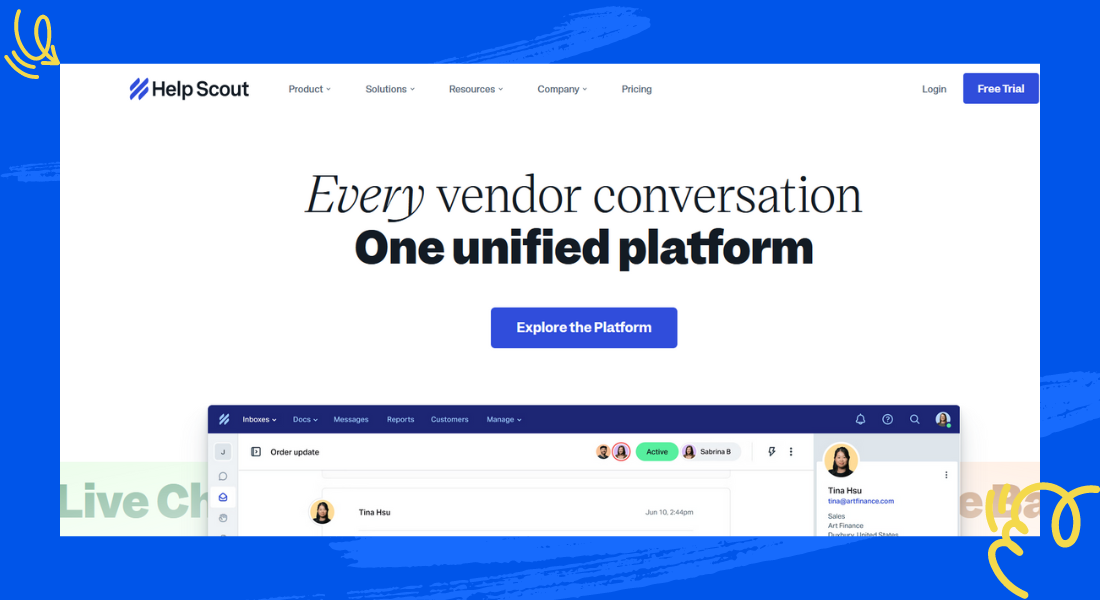
Help Scout is a customer support platform designed to streamline communication and improve customer experience. It offers a shared inbox system for managing all customer inquiries – emails, chats, and voice messages – in one place. Unlike traditional ticketing systems, Help Scout emphasizes a conversational approach, fostering a more personal connection between support teams and customers.
Key Features
- Shared Inbox: Manage all customer interactions (email, chat, voice) in a central location for efficient collaboration.
- Live Chat: Offer real-time support to customers directly on your website.
- Knowledge Base: Build a self-service portal with articles and FAQs to empower customers to find solutions independently.
- Automation: Automate repetitive tasks like sending welcome emails or routing tickets based on keywords.
- Reporting: Gain insights into customer support performance with detailed reports and analytics.
Pros
- User-friendly interface with a focus on conversation.
- Shared inbox for efficient teamwork and collaboration.
- Built-in live chat and knowledge base for comprehensive support.
- Automation features to streamline workflows.
- Integrates with various third-party tools.
Cons
- Lacks phone support (available through integrations).
- Pricing can be higher compared to some basic ticketing systems.
- Limited customization options for the shared inbox interface.
Help Scout Pricing
Help Scout offers very straightforward and transparent pricing plans. They have various plans that are charged per agent use. They start at $25/agent per month.
HappyFox
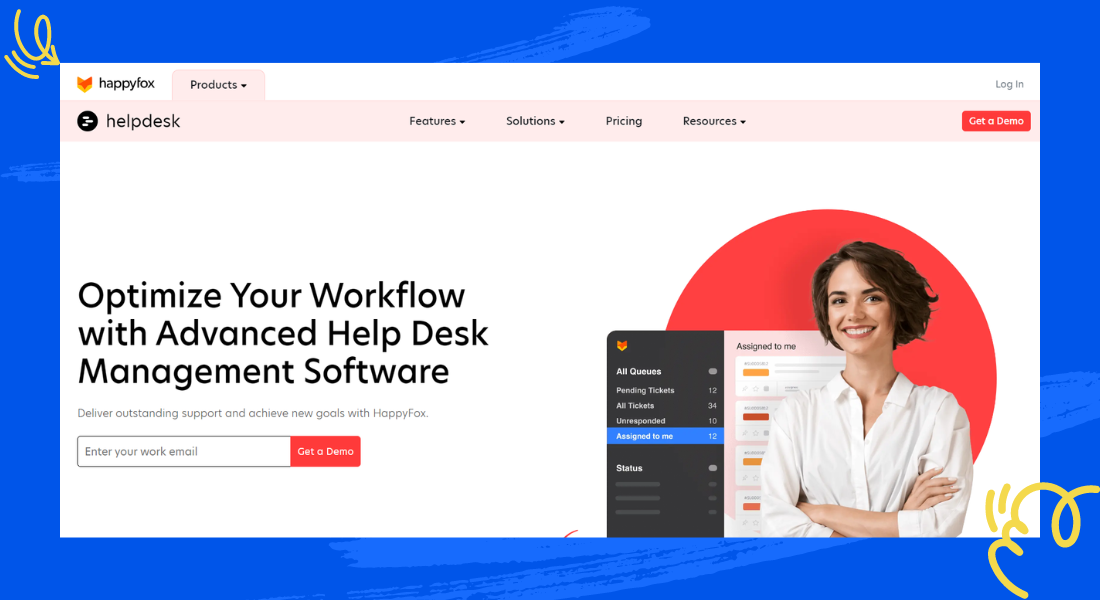
HappyFox is an easy-to-use and configurable help desk ticketing system designed to streamline customer support across all teams. It offers a range of features to manage support requests efficiently, collaborate with team members, and provide exceptional customer service.
Key Features
- Ticketing System: Create custom ticket queues, categorize tickets, manage omnichannel support (email, social media, chat, phone calls), set ticket statuses, and pin important tickets.
- Ticket Management: Perform quick actions on tickets (change priority, status, due date, assignees), use quick reply, apply bulk actions, and advanced search/filtering.
- Productivity Tools: Canned responses, auto-timers, collision avoidance, and streamlined collaboration with private notes and attachments.
- Reporting and Analytics: Access detailed ticket information, customize contact details, integrate with other apps, and subscribe to ticket actions.
- Knowledge Base: Build a no-code, drag-and-drop knowledge base for self-service, multi-brand support, multi-lingual capabilities, and customization options.
- Asset Management: Track and manage hardware and software assets.
- Automation: Automate ticket assignments, trigger smart rules, and reduce SLA breaches.
- Call Center: Provide omnichannel support with phone integration (RingCentral, AirCall), troubleshoot issues, and measure customer satisfaction (CSAT) rates.
Pros:
- Easy to configure and use
- Omnichannel support
- Collaboration and productivity tools
- Customizable knowledge base
- Asset management capabilities
- Automation and workflow features
- Call center integration
Cons:
- Pricing information not provided in the given data
- Specific integrations and advanced features may require additional costs
HappyFox Pricing
HappyFox offers both agent-based and unlimited agent packages that cater to different team sizes and needs. The pricing starts at $39/user per month.
osTicket
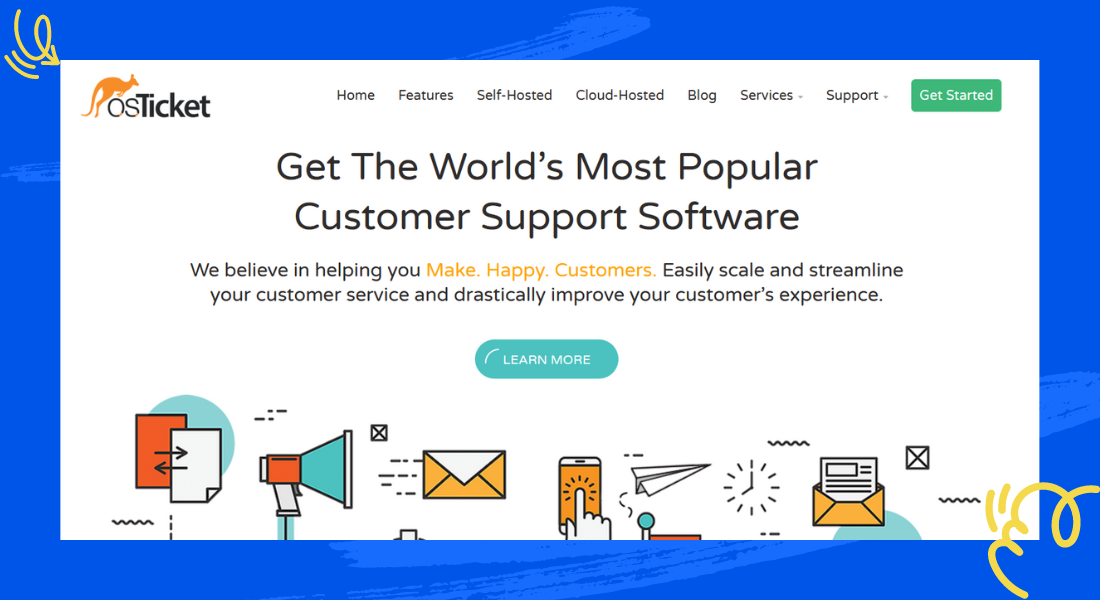
osTicket is a free and open-source trouble ticket software that helps businesses streamline their customer support by managing and organizing support requests. It provides a central platform for agents to track, prioritize, and resolve issues submitted through various channels like email, web forms, and even APIs.
Key Features
- Ticketing System: Manage and track all customer support requests in a single, organized interface.
- Customer Portal: Allow customers to submit tickets, track their progress, and access a knowledge base for self-service.
- Automatic Routing: Route tickets to the appropriate agent or department based on predefined rules.
- SLA Management: Set Service Level Agreements (SLAs) to ensure timely resolution of tickets.
- Reporting & Dashboards: Gain insights into your support performance through detailed reports and visual dashboards.
- Customization: Tailor osTicket to your specific needs with customizable workflows, forms, and branding.
Pros:
- No licensing fees, allowing for budget-friendly implementation.
- Suitable for businesses of all sizes, from small teams to large enterprises.
- Offers a comprehensive set of features for efficient support management.
- Can be customized to fit your specific support needs and workflows.
- Backed by a large and active community for support and development.
Cons:
- Requires technical expertise to install and maintain on your own server.
- Relies on community support for troubleshooting, with no official paid support options.
- Extensive customization may require coding knowledge.
osTicket Pricing
osTicket is free and open-source software. There are no licensing fees. However, costs may arise if you need paid hosting for the software or require professional help for installation and customization. This amounts to $9/user per month.
Top Features to Look out for in a Trouble Ticket Software
Trouble ticket software is an essential tool for any organization that wants to streamline its support operations and provide efficient customer service. With the right trouble ticket software, businesses can manage incoming requests, assign tasks, track progress, and ensure timely resolution of issues. However, with numerous options available in the market, it can be challenging to choose the right software that meets your specific needs. Here are the top features to look for when evaluating trouble ticket software:
- Intuitive User Interface: The software should have a user-friendly interface that is easy to navigate for both support agents and customers. A well-designed interface can simplify the process of creating, updating, and tracking tickets, reducing the learning curve and increasing productivity.
- Multi-Channel Support: Modern trouble ticket software should support multiple channels of communication, such as email, web forms, live chat, social media, and even phone calls. This feature ensures that customers can submit their requests through their preferred channel, improving customer satisfaction and convenience.
- Automated Ticket Routing: An efficient trouble ticket software should have automated routing capabilities that assign incoming tickets to the appropriate support agent or team based on predefined rules. This feature ensures that tickets are handled by the most qualified personnel, reducing response times and improving resolution rates.
- Knowledge Base Integration: A robust knowledge base integrated with the trouble ticket software can significantly enhance the support experience for both agents and customers. Agents can quickly access relevant articles and solutions, while customers can find answers to common questions without having to submit a ticket, reducing the overall ticket volume.
- Customizable Workflows: Trouble ticket software should offer customizable workflows that align with your organization’s specific processes and procedures. This feature allows you to define custom statuses, priorities, and escalation rules, ensuring that tickets are handled consistently and efficiently.
- Reporting and Analytics: Comprehensive reporting and analytics capabilities are essential for tracking performance metrics, identifying bottlenecks, and making data-driven decisions. Look for software that provides detailed reports on ticket volume, response times, resolution rates, and customer satisfaction ratings.
- Collaboration and Communication Tools: Effective collaboration and communication among support teams are crucial for resolving complex issues. The trouble ticket software should include features like internal notes, file attachments, and real-time notifications to facilitate seamless collaboration and keep stakeholders informed.
- Mobile Accessibility: With the increasing use of mobile devices, it’s important to choose trouble ticket software that offers mobile accessibility. This feature allows support agents to manage tickets and respond to customer inquiries while on the go, improving response times and overall efficiency.
- Integration Capabilities: Trouble ticket software should seamlessly integrate with other tools and systems used within your organization, such as customer relationship management (CRM) software, project management tools, and communication platforms. This integration ensures a streamlined workflow and eliminates the need for manual data entry or switching between multiple applications.
- Scalability and Customization: As your business grows, your trouble ticket software should be able to scale and adapt to your changing needs. Look for software that offers customization options, such as custom fields, workflows, and branding, to ensure a seamless fit with your organization’s unique requirements.
Benefits of a good Trouble Ticket Software
Implementing a robust and feature-rich trouble ticket software can provide numerous benefits to organizations, streamlining support operations, enhancing customer satisfaction, and improving overall efficiency. Here are some of the key advantages of investing in a high-quality trouble ticket software:
- Improved Customer Experience: A good trouble ticket software ensures that customer inquiries and issues are promptly acknowledged, tracked, and resolved in a timely manner. By providing a centralized platform for customers to submit requests and receive updates, the software enhances transparency and communication, leading to higher customer satisfaction levels.
- Increased Operational Efficiency: With automated ticket routing, knowledge base integration, and customizable workflows, trouble ticket software can significantly improve the efficiency of support teams. Agents can quickly access relevant information, prioritize tasks, and follow standardized processes, reducing the time and effort required to resolve issues.
- Better Collaboration and Communication: Trouble ticket software facilitates seamless collaboration and communication among support teams, managers, and other stakeholders. Features like internal notes, file attachments, and real-time notifications enable teams to work together effectively, share information, and resolve complex issues more efficiently.
- Enhanced Accountability and Visibility: Detailed reporting and analytics capabilities provide valuable insights into support operations, allowing managers to monitor performance metrics, identify bottlenecks, and make data-driven decisions. This visibility ensures accountability and enables continuous improvement in service delivery.
- Scalability and Flexibility: A good trouble ticket software is designed to scale and adapt to the changing needs of an organization. As the business grows, the software can accommodate increasing ticket volumes, additional support channels, and evolving workflows, ensuring that support operations remain efficient and effective.
- Centralized Knowledge Management: By integrating a comprehensive knowledge base with the trouble ticket software, organizations can create a centralized repository of solutions, best apology practices, and frequently asked questions. This knowledge base empowers support agents to quickly find and share relevant information, reducing resolution times and ensuring consistent service delivery.
- Compliance and Audit Trail: Many trouble ticket software solutions offer robust reporting and audit trail capabilities, which are essential for organizations operating in regulated industries or those with strict compliance requirements. These features help maintain accurate records of interactions, actions taken, and resolutions, ensuring transparency and adherence to industry standards.
- Cost Savings: By streamlining support operations, reducing response times, and improving first-call resolution rates, a good trouble ticket software can lead to significant cost savings for organizations. Efficient support processes minimize the need for escalations, reduce operational overhead, and improve overall productivity.
Investing in a high-quality trouble ticket software is not just an investment in technology but also an investment in enhancing customer experiences, improving operational efficiency, and driving business growth. By leveraging the power of a robust trouble ticket solution, organizations can position themselves as leaders in customer service and support excellence.
Choosing the Right Help Desk Trouble Ticket Software
Let’s be honest; with so many trouble ticket software options out there, finding the right one for your business can feel like navigating a minefield. But fear not, because we’re here to guide you through this process and ensure you make an informed decision that perfectly aligns with your unique needs. Just follow this checklist and by the end, you’ll have a clear picture of your priorities that you can use to find the best Trouble Ticket Software for your business.
✔️Know Thy Needs: First things first, take a good hard look at your organization’s specific requirements. What kind of support channels do your customers prefer? Do you need robust self-service options? How complex are the issues your team typically handles? Understanding these nitty-gritty details will help you narrow down your options and avoid settling for a solution that just won’t cut it.
✔️Think Long-Term: Your business is a growing, thriving entity (or at least, we hope it will be!), so you’ll want a trouble ticket software that can grow with you. Look for solutions that can seamlessly adapt to increasing ticket volumes, additional support channels, and evolving workflows without skipping a beat.
✔️Play Nice with Others: Integration capabilities are crucial, my friends. Does the software play nice with your existing tools and systems, like your CRM, project management software, or communication platforms? Trust me; you don’t want to be constantly juggling between multiple applications or manually transferring data. A seamless integration will save you time, reduce human error, and keep your sanity intact.
✔️Embrace Uniqueness: Every business is a special snowflake, and your trouble ticket software should reflect that. Seek out solutions that offer customizable workflows, branding options, and the ability to create custom fields and statuses. This flexibility will ensure that the software aligns perfectly with your processes and brand identity.
✔️Data, Data, Data: Reporting and analytics are often overlooked but are absolute game-changers. Look for software that provides detailed reports on ticket volume, response times, resolution rates, and customer satisfaction. These insights will help you identify areas for improvement, optimize your support operations, and make data-driven decisions that drive business growth.
✔️User-Friendly or Bust: Let’s talk about the user experience – for both your support team and your customers. A clunky, unintuitive interface can be a productivity killer and a surefire way to frustrate your customers. Prioritize software with a user-friendly design that makes creating, updating, and tracking tickets a breeze for everyone involved.
✔️Security and Compliance: Depending on your industry, you may have strict data privacy and security requirements to adhere to. Ensure that the trouble ticket software you choose offers robust security features, such as encryption, access controls, and audit trails, to protect sensitive information and maintain compliance. Look for software that meets industry standards and has obtained certifications such as:
- ISO 27001: This internationally recognized standard outlines best practices for establishing, implementing, maintaining, and continually improving an information security management system (ISMS) within an organization.
- SOC 2: Service Organization Control (SOC) 2 reports review the security, availability, processing integrity, confidentiality, and privacy of a service organization’s systems. Look for trouble ticket software providers that have completed a SOC 2 Type II audit, which evaluates the operational effectiveness of their controls.
- GDPR Compliance: If your organization handles data from European Union citizens, ensure that the trouble ticket software is compliant with the General Data Protection Regulation (GDPR), which outlines strict rules for data protection and privacy.
- HIPAA Compliance: For organizations in the healthcare industry, HIPAA (Health Insurance Portability and Accountability Act) compliance is crucial. Look for trouble ticket software that meets HIPAA requirements for protecting sensitive patient health information.
- PCI DSS Compliance: If your business handles credit card transactions, the trouble ticket software should be compliant with the Payment Card Industry Data Security Standard (PCI DSS), which outlines requirements for securing customer payment data.
- FedRAMP Certification: For organizations working with U.S. government agencies, FedRAMP (Federal Risk and Authorization Management Program) certification ensures that the trouble ticket software meets stringent security standards for cloud-based services.
Remember, it’s highly unlikely that you’ll find software that ticks all the boxes for your business. You’ll have to prioritize some features and actively analyze whether the pros outweigh the cons. One thing is certain, however: choosing the right trouble ticket software is an investment in your business’s success.
Take the time to evaluate your options, involve key stakeholders in the decision-making process, and don’t be afraid to ask tough questions. With the right solution in place, you’ll be well on your way to providing exceptional customer support, streamlining your operations, and driving growth for years to come.
Following the Best Practices for Trouble Ticketing and their Effects
Getting the right Trouble Ticket Software is just one part of the puzzle.
Remember it’s just a tool. At the hands of an unskilled technician, the capabilities of the most advanced tool will be wasted.
Hence, you need to ensure that certain standards and procedures are followed so that the most effective solution can be provided.
Here are a few best practices businesses should follow to make Trouble Ticketing as effective a tool as possible.
| Best Practice | What it means | Effect of Following | Potential Consequences of Not Following |
|---|---|---|---|
| Standardize Processes | Establish clear and consistent procedures for handling tickets, defining priorities, categories, and escalation procedures. | Consistent ticket handling, clear prioritization, and efficient escalation procedures | Inconsistent service, missed priorities, and lack of accountability |
| Encourage Detailed Ticket Submissions | Train customers and employees to provide comprehensive information, including problem descriptions, steps to reproduce, error messages, and supporting documentation. | Faster issue diagnosis and resolution, reduced back-and-forth communication | Incomplete information, delayed resolutions, and customer frustration |
| Implement Knowledge Base Integration | Maintain a comprehensive knowledge base seamlessly integrated with the trouble ticket software for quick access to solutions. | Quicker access to solutions, increased first-call resolution rates, and knowledge sharing | Duplicated efforts, longer resolution times, and knowledge silos |
| Prompt Communication | Keep customers informed throughout the ticket lifecycle by providing regular status updates, even if there’s no immediate resolution. | Improved customer satisfaction, trust, and transparency | Customer frustration, lack of visibility, and potential loss of business |
| Encourage Self-Service | Provide self-service options like knowledge bases, FAQs, and chatbots to empower customers to find solutions independently. | Reduced support workload, catering to customer preferences, and 24/7 support availability | Increased ticket volume, longer wait times, and dissatisfied customers |
| Leverage Automation | Implement automation rules and workflows to streamline ticket handling processes, such as automatic ticket assignment and response templates. | Streamlined processes, reduced manual efforts, and increased efficiency | Inefficient resource allocation, manual errors, and delays |
| Continuous Training | Provide regular training sessions for the support team to ensure they stay up-to-date with the latest features, processes, and best practices. | Skilled and knowledgeable support team, consistent service delivery, and improved performance | Knowledge gaps, inconsistent support quality, and customer dissatisfaction |
| Analyze and Optimize | Regularly review trouble ticketing data and performance metrics to identify areas for improvement and implement changes. | Identification of improvement areas, data-driven decision making, and continuous process enhancement | Unaddressed bottlenecks, inefficient resource allocation, and stagnant operations |
| Foster Collaboration | Encourage collaboration among support team members and cross-functional collaboration with other departments when necessary. | Holistic issue resolution, knowledge sharing, and cross-functional synergy | Siloed operations, duplicated efforts, and potential missed opportunities |
| Continuous Improvement | Treat trouble ticketing as an ongoing process of continuous improvement by regularly reviewing and refining processes, documentation, and knowledge base content. | Adaptability to changing needs, proactive problem-solving, and long-term customer satisfaction | Outdated processes, stagnant operations, and potential loss of competitive edge |
This table provides a clear understanding of what each best practice entails, the benefits of following it, and the potential consequences of not adhering to it. It serves as a comprehensive guide for organizations to implement effective trouble ticketing practices and realize the associated benefits.
Summing up!
To sum up, trouble ticket software is instrumental in optimizing customer support processes and boosting overall productivity. This article has provided insights into its definition and functionalities and highlighted the top ten options available in the market. From ThriveDesk to osTicket, each software offers distinct features to meet diverse organizational needs.
Furthermore, we’ve discussed key features to consider when selecting a trouble ticket software and outlined the benefits it brings, including improved customer satisfaction and streamlined team collaboration. Emphasizing the importance of adhering to best practices in trouble ticketing, we’ve demonstrated their positive impact on organizational efficiency and customer experience.
Ultimately, investing in the right trouble ticket software and following best practices can drive enhanced customer service, foster loyalty, and propel business growth in today’s competitive landscape.

